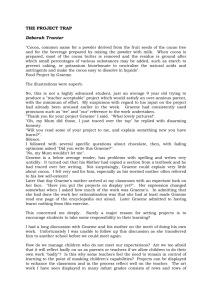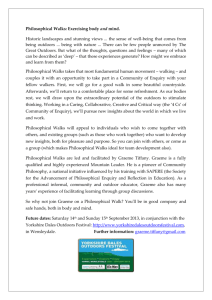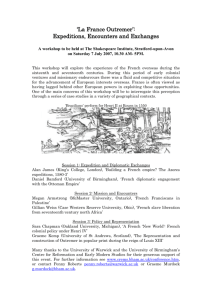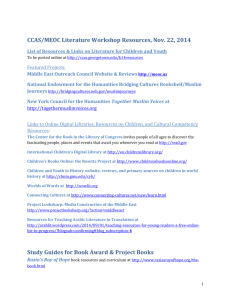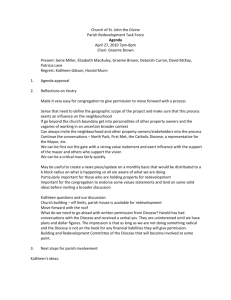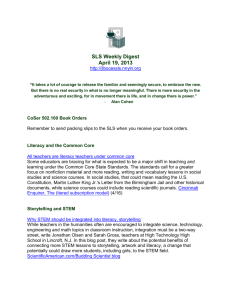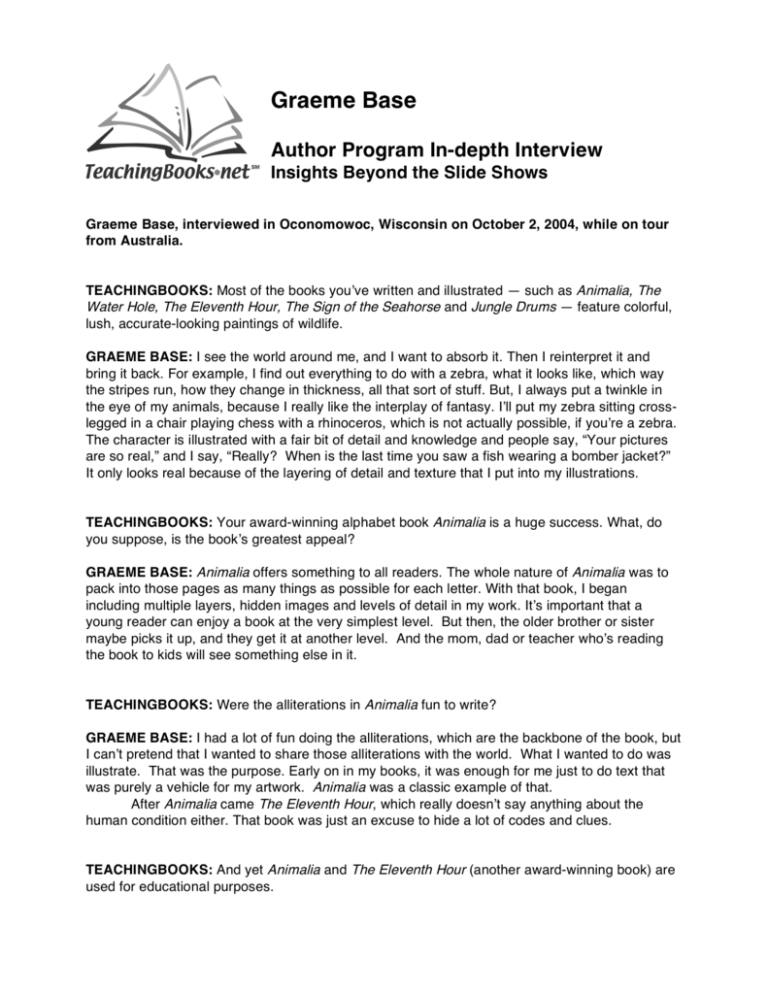
Graeme Base
Author Program In-depth Interview
Insights Beyond the Slide Shows
Graeme Base, interviewed in Oconomowoc, Wisconsin on October 2, 2004, while on tour
from Australia.
TEACHINGBOOKS: Most of the books you’ve written and illustrated — such as Animalia, The
Water Hole, The Eleventh Hour, The Sign of the Seahorse and Jungle Drums — feature colorful,
lush, accurate-looking paintings of wildlife.
GRAEME BASE: I see the world around me, and I want to absorb it. Then I reinterpret it and
bring it back. For example, I find out everything to do with a zebra, what it looks like, which way
the stripes run, how they change in thickness, all that sort of stuff. But, I always put a twinkle in
the eye of my animals, because I really like the interplay of fantasy. I’ll put my zebra sitting crosslegged in a chair playing chess with a rhinoceros, which is not actually possible, if you’re a zebra.
The character is illustrated with a fair bit of detail and knowledge and people say, “Your pictures
are so real,” and I say, “Really? When is the last time you saw a fish wearing a bomber jacket?”
It only looks real because of the layering of detail and texture that I put into my illustrations.
TEACHINGBOOKS: Your award-winning alphabet book Animalia is a huge success. What, do
you suppose, is the book’s greatest appeal?
GRAEME BASE: Animalia offers something to all readers. The whole nature of Animalia was to
pack into those pages as many things as possible for each letter. With that book, I began
including multiple layers, hidden images and levels of detail in my work. It’s important that a
young reader can enjoy a book at the very simplest level. But then, the older brother or sister
maybe picks it up, and they get it at another level. And the mom, dad or teacher who’s reading
the book to kids will see something else in it.
TEACHINGBOOKS: Were the alliterations in Animalia fun to write?
GRAEME BASE: I had a lot of fun doing the alliterations, which are the backbone of the book, but
I can’t pretend that I wanted to share those alliterations with the world. What I wanted to do was
illustrate. That was the purpose. Early on in my books, it was enough for me just to do text that
was purely a vehicle for my artwork. Animalia was a classic example of that.
After Animalia came The Eleventh Hour, which really doesn’t say anything about the
human condition either. That book was just an excuse to hide a lot of codes and clues.
TEACHINGBOOKS: And yet Animalia and The Eleventh Hour (another award-winning book) are
used for educational purposes.
www.TeachingBooks.net
GRAEME BASE: Yes, I realize that both of those books actually have a lot of educational value,
but the point is I didn’t intend it. I’ve been getting letters for 20 years now from people saying how
they use Animalia and The Eleventh Hour to teach kids about clear thinking or observation,
deduction, math concepts, geography concepts, all sorts of stuff.
TEACHINGBOOKS: Readers young and old continue to delight in solving the mystery of The
Eleventh Hour. Where did the idea for a visual crime story come from?
GRAEME BASE: After Animalia, I was struck by a mild sense of panic. Animalia had been a
huge hit — totally unexpectedly — and the term “one-hit wonder” had a real resonance for me. I’d
been reading some Agatha Christie books, and I thought, “What if I make a mystery story and
hide all my clues in the artwork?” And quite literally moments later, the title, The Eleventh Hour
fell out of the roof, onto the drawing board. I had no idea what the story was, but I decided it was
going to be called The Eleventh Hour. So I started thinking, “Okay, a book called The Eleventh
Hour, clearly it’s going to be revolving around the number 11. Eleven animals go to an 11th
birthday party on the 11th of November. They play 11 games.”
And then I thought, “At 11:00, we have them all go into one of the rooms, maybe the
drawing room or the great library, and there’s one of the guests, the dog, dead in a chair. I told my
publishers this, and they were absolutely horrified. They said, “Graeme, you cannot have dead
dogs in picture books.” It seemed a pity. I thought it was kind of cool. But, I had to go back and
think what is it that people really like about parties? And, of course, the answer was food. So, I
made it a story about a missing feast.
And The Eleventh Hour carried on what had become a tradition by this point of including
all these codes and clues and hidden ciphers.
TEACHINGBOOKS: At what point did you begin to include a subtext in your books?
GRAEME BASE: Probably starting with The Sign of the Seahorse, I began to want to say things
in the book. I don’t think it’s coincidental that that’s also the time when I became a dad. Now we
have three kids. Parenting changes one’s view of the world.
I suddenly realized that I was in an incredibly fortunate profession — where I could really
enjoy myself — and I could do something potentially useful: I could say something about the
world.
The Sign of the Seahorse started off for me just as a joy. I’d had my first scuba diving
experience, and it was going to be just a simple book about these fishy characters that live under
water. But then I discovered in my research for the book’s illustrations that we’re losing coral reef
faster than rainforest. So, underneath the surface of my book, I included this story of the loss of a
coral reef.
In Seahorse, I tried consciously to make a break from including hidden images, and tried
to just tell an adventure story. But in the end, I couldn’t help myself — I still had two little shrimp
who have their own story that runs through the pages. The book doesn’t talk about them at all, but
you can track their own little adventure story.
TEACHINGBOOKS: In your next concept book, The Water Hole, you included a very clear
message along with your hidden animals.
2 of 10
www.TeachingBooks.net
GRAEME BASE: The Water Hole is a counting book with similar sorts of layers to Animalia.
Although it’s a concept book, there are other levels within it — little frogs go from ten to one at the
dark moment when the water is all gone. Then all the animals come back with the water, so now
the reader can count everything back up to ten.
The subtext on that one is about conservation, specifically about water as a global
resource. Initially, the water hole is in Africa, but on the next page, it is in India, and then on
around the world from there. Finally, with ten kangaroos, we’re in Australia. At the very end, all of
the animals are drinking at just one water hole. If you look back at the page before, where it says,
“It rained and rained and rained,” you’ll see all the water spreading out in the shape of the world.
And just before that, there’s a page that has just a big, single raindrop, and if you look really
carefully into that raindrop, you can see a hazy image of the world there as well.
TEACHINGBOOKS: Did The Water Hole begin as a global book?
GRAEME BASE: The Water Hole was initially going to be set totally in Africa and it was going to
be about the cycle of seasons; a counting book inspired by the idea of when a water hole shrinks,
more and more and more animals drink there. The layers of meaning began to come into it later.
The concepts for my books don’t happen instantly. I don’t say, “Oh, wow, here’s a chance
to do a book with this layer and that layer and this hidden meaning, or even the hidden animals.”
That’s often why my books take as long as they do: somewhere between two and three years per
book. I don’t spend all of that time painting or writing. A lot of it is spent thinking, revising, or just
working out how all of these layers can be made to slide in together and give the book a depth
that will actually make it worth spending that much time on.
TEACHINGBOOKS: Jungle Drums is a book similar to The Water Hole, in terms of the hidden
animals and the setting.
GRAEME BASE: Yes. At the moment I’m two-thirds of the way through a trilogy, or at least three
books that have a loose association through having jungle/forest themes. The first was The
Water Hole, inspired by Africa, but going all over the world and showing fairly representative
versions of animals from each place. Jungle Drums is set in just one place and is more of a fable
— talking about tolerance.
The next book is called Uno’s Garden. It is, perhaps, the most interesting or challenging of
the three for me. It’s set in a forest, and it is about the balance between the natural world and the
world of humans. We’re part of the natural world. We should never think of ourselves as being
some sort of aberration nor a blight on the world. We’re a very powerful part of the world and
we’ve got to be very careful about the way that we touch it. When we build a city or when we
indulge in farming, it used to be that you’d just cut down all the trees and you put up all the
buildings or you just plow them down and put in the seeds. We now know that approach doesn’t
work. So the third book in this loose jungle trilogy is about achieving that balance between nature
and us.
Uno’s Garden is really a fantasy; it doesn’t spring so directly from my experiences of
Africa, which very largely informed The Water Hole and Jungle Drums. And yet, I sense a natural
progression. In The Water Hole, the animals were very representative. In Jungle Drums, the
animals were more stylized and younger, sort of like toy animals. And now in Uno’s Garden, I’ve
extended that idea — making the creatures very familiar, and yet not quite the same.
3 of 10
www.TeachingBooks.net
TEACHINGBOOKS: Please explain more about what Jungle Drums is about.
GRAEME BASE: My books usually start out with a simple story line. With Jungle Drums, I
wanted to write a story about a little warthog, because I had been surrounded by the incredible
majesty of nature in Africa: the biggest, the tallest, the stripiest, the spottiest, and I thought,
“Being a warthog is a tough gig — these are not pretty animals.” But they’re endearingly cute. So,
on the surface, Jungle Drums is a sweet little story about this little warthog who thinks he doesn’t
want to be small anymore. Then along comes his fairy godmother, Nyumbu. She’s a wildebeest.
She tells him that there’s a solution, and he thinks, “I’m going to be bigger.” But, you see, he
doesn’t know that there’s nothing wrong with him; he’s okay being small. It’s everyone else who
has the problem by not accepting him. And luckily the fairly godmother understands that it’s they
who need to change and stop seeing themselves as better and him as worse. And that’s the
message of tolerance.
TEACHINGBOOKS: You’ve talked about travel to Africa and scuba diving. How do your travels
and adventures impact your work?
GRAEME BASE: Going to Africa is the single most inspirational thing I’ve ever been able to do,
and my books reflect this. I’m interested in drawing the things that I’m passionate about, such as
nature.
I’m able to travel a lot, and the best kind of travel is when you can get somewhere, stay
there for a while and just soak it in. However, I’m not the kind of guy who takes a sketchpad into
the outback and draws. I take a lot of photographs, and I find that they’re a good record. The
photos remind me of the feeling and the inspiration of being there. When I get back to my studio,
I’ll then take out the photographs and that will inspire me afresh. I also find there’s nothing like
getting great photographs from people who really know what they’re doing, to see the detail of
things like the fur direction on the nose of a leopard. I want to know the subtleties of an animal’s
make-up when I’m creating my illustrations. Then, I’ll subvert that knowledge and do my own
thing with it.
TEACHINGBOOKS: At what age did you decide you wanted to be an artist?
GRAEME BASE: I wanted to be an artist since I was about 11 years old. All through high school,
I was drawing and painting. I went to college for graphic design, because I liked the title of
“commercial artist,” and I thought, “Wow, that sounds great — you draw pictures and you get paid
for it.” But the reality was that there was nothing creative about a job in commercial art.
TEACHINGBOOKS: How did you end up in children’s books?
GRAEME BASE: I was working for advertising companies fresh out of college, and I went
through three in about 18 months. I got fired from the third one, and I was actually pretty happy to
be let go; I was having a rotten time. I’d come into the office in the morning, and there would be a
pile of work for me to do. My boss would say, “Don’t worry about that one, because it doesn’t
have to be done until 11:00 this morning. This one has to be done right now; you have 45 minutes
to draw this toothpaste packet.” It was just insane.
When I asked why they fired me, they said, “Because you’re incompetent, Graeme.” I
couldn’t really argue with that, because I knew I was doing bad work. It’s very hard to do good
4 of 10
www.TeachingBooks.net
work if you don’t enjoy it. At that point, I took all the artwork which I had been doing in the
evenings (what I considered my real art), and took it around to publishers, trying to get work doing
book jackets. I did a couple of book jackets, and then they said, “Maybe you could do some
illustrations for this story, a book called Creation Stories.” So I did those. And I thought, “This is
a lot better than what I was doing in advertising.” It was much more creative, but it wasn’t perfect.
Then I thought, “Hey, I used to be okay at English at school; maybe I could have a crack
at writing my own text. So I wrote and illustrated a poem called, My Grandma Lived in Gooligulch.
It was a very Australian story, and bingo! They published it. It was amazing.
TEACHINGBOOKS: Looking back, what are your thoughts about that first book?
GRAEME BASE: I think My Grandma Lived in Gooligulch was, in reflection, quite an innocent,
almost naïve first go at what a children’s book is. I mean, I honestly didn’t know what I was
doing. The fact that I very quickly gravitated toward a grandma was fairly predictable, including
how she talks with the animals. It wasn’t terribly original. But, again, it was a vehicle for my
artwork, which I so often do. I’ll have a beautiful image that I want to draw for its own sake, so I
will actually craft a story that allows me to do it.
TEACHINGBOOKS: What artistic challenges did you face in creating your first children’s book?
GRAEME BASE: I was sort of left to my own devices. I’ve kind of made up my own style of
painting over a long period of time. At college, I was taught a lot about spatial dynamics, about
topography, about deadlines, but not really about painting technique as such. In My Grandma
Lived in Gooligulch, I drew every second page in black and white, which is I felt very comfortable
with. I was quite uncomfortable with color illustration, and I think it’s clear in a lot of those pictures
that I was struggling to work out what color was all about.
TEACHINGBOOKS: You said you wanted to be an artist since you were a child. Did you ever
create your own book back then?
GRAEME BASE: Yes, a book on dragons. When I was only nine or 10, I did a book on lined
paper with colored pencils called, A Field Guide to Monsters of the World. And it was all the
monsters you will find in a trashcan or under the bed or anywhere. I included where they live and
who they eat, how big they are, etc. Of course, it was never published. But years later, I did a
calendar called Dragons, Draaks and Beasties. I illustrated 12 dragons that I made up, plus
spurious information about them.
TEACHINGBOOKS: You illustrated Lewis Carroll’s Jabberwocky. What was that like?
GRAEME BASE: I jumped at the opportunity because the poem, Jabberwocky is the only poem
I’ve ever known by heart. My father taught it to me when I was pretty young, maybe 11 or 12.
And I just loved the total nonsense of it, and the fact that you could then make up anything you
like. The day my dad taught me the poem, after every one of those nonsense verses he said, “So
what does that mean?” And we went through each word and I told him what I thought each of
those words meant, and he told me what he thought. And I realized that this was fantastically
fertile ground for illustrating.
5 of 10
www.TeachingBooks.net
TEACHINGBOOKS: What other books did you enjoy as a child?
GRAEME BASE: The books I sort of read or had read to me when I was little were very much
the English fare: Lewis Carroll, A.A. Milne, Kenneth Graham. I’ve always felt my work has a very
strong English influence. I think my interest and love of word play tends to be a more English trait
than anything else.
Interestingly, though, my books are generally much better known in America than they are
in England. I’m known in my home country of Australia, certainly, but they’ve tended to gravitate
more to the American sort of mind.
TEACHINGBOOKS: Music has also been an important part of your life. How did you come to
choose illustration over making music?
GRAEME BASE: Up until Animalia was published, it was a real toss-up as to whether I was
going to go down an art path or a music path. Music had been, for some years, my primary
passion. I was in a rock band — I joined the band because I fancied the lead singer, who later
became my wife, Robyn. She was in the band already and I joined as the drummer. We kept
losing guitarists. When we lost the fifth guitarist, or so, it just happened to coincide with when
Animalia was published. I said, “Let’s just go overseas for a while and take some time off and
then we’ll come back and start the band up again.” During that time, Animalia just went crazy —
sales went through the roof, and suddenly this was now my career. I never did put the band back
together again.
But, music’s always been very, very close to artwork in my heart. In fact, I have on
several occasions tried to marry the two things together. If you look at the cover of The Sign of
the Seahorse, you’ll see a little logo that is half seahorse and half treble clef. That’s what actually
informed the title of the book. When I first wrote that book, it was as a musical, but then I rewrote
it in rhyming couplets. I love writing verse because, for me, it’s a form of music. With The Worst
Band in the Universe, the musical link is obvious. There’s even a CD of terribly recorded music
(which I did all myself) in the back of the book.
TEACHINGBOOKS: The Worst Band in the Universe is a divergence from your previous books,
both in subject matter and in age level.
GRAEME BASE: The Worst Band in the Universe took five years for me to create, which was
longer than I’ve spent on anything else. I really lost the plot with that one and then came back to
it and lost it again and then found it again. And I know now what the problem was: it should never
have been a picture book. It should have actually been my first middle grade novel, because it
really about teenagers or at least aspiring teenagers and it was about rock and roll and freedom
of speech, and I was just trying to force this much bigger and older idea into a picture book
format. If I had the chance, I would revisit The Worst Band. It might be with a graphic novel or it
would certainly be in a longer form and probably not written in verse.
Having said that, The Worst Band remains a favorite and it remains a concept that I’m
very much attached to. It was important to me to be able to say that everybody has their own
voice, and every generation plays their own music.
6 of 10
www.TeachingBooks.net
TEACHINGBOOKS: Truck Dogs, your first middle grade novel, fills a niche with male youth and
reluctant readers.
GRAEME BASE: I think it’s true to say that Truck Dogs has got a narrower specific potential
audience. It’s not limited to it, but it quite definitely appeals to middle grade kids, I think especially
boys. It has that capacity to resonate with those boys at that age where it’s so crucial that we get
them reading. And I’m very pleased that Truck Dogs is maybe filling that hole.
TEACHINGBOOKS: What caused you to envision creatures that are half dog, half motor vehicle?
GRAEME BASE: I remember seeing trucks hammering down the highway as a kid, and they had
a real animal intensity. The long hood was like a snout, the headlights were like flared nostrils, the
grill was teeth, and behind the windshield, I was sure there were eyes.
Some years ago, as I was driving through Central Australia, I saw a “road train.” A road
train is a great big truck with several big trailers attached; they’re vast things, and are quite
terrifying to see coming down the road toward you. The one that I passed actually had a mascot
— some toy dog taped to the front of the grill. I thought, “That’s it. This is a truck dog.” So, while I
was traveling through the Outback, I began drawing up all these ideas for my truck dogs and
conceived of an Outback Australian world populated by nothing but truck dogs and associated
truck creatures.
TEACHINGBOOKS: How did you decide on the format for Truck Dogs as a middle grade chapter
book?
GRAEME BASE: Truck Dogs couldn’t be a picture book, because it was about kids (the dogs are
actually kids) who were at an older developmental stage. It was speaking to a slightly older,
aspiring teen readership.
However, Truck Dogs was initially going to be a picture book, and I spent a year working
on it in that format, including writing the text in verse. But then, these warning bells rang in the
back of my mind telling me that I’ve been here before. I remember thinking with The Worst Band
in the Universe that this was something which had the potential to go in another direction. And
with Truck Dogs I thought, “I’m going to do this — I’m going to take a huge leap, leave a year’s
work behind and go back and start again.”
So I opened up a new page, and wrote, Truck Dogs, the Movie. I started writing a
screenplay, taking the whole idea to another level, and divorcing myself from the picture book by
doing something very, very different. And over about six, eight weeks I wrote the screenplay,
which may or may not ever go anywhere, but it very effectively then left the old version of Truck
Dogs, the picture book, behind and gave me something new to work on.
Then, I rewrote that again, this time as a novel. With the truck dogs being such weird
creations, I thought probably it would help to show readers what they looked like as well as
describing them in words, because these are very peculiar beasties. I wanted to show the
specifications of what each truck dog eats and what sort of petrol to put in it, how often you have
to worm it and what kind of capacity the engine is — a real mixture of truck and dog.
TEACHINGBOOKS: Describe a typical workday.
7 of 10
www.TeachingBooks.net
GRAEME BASE: I work from home in a studio upstairs above the kitchen. The day typically starts
after I’ve got the kids off to school. That’s my job in the mornings; my wife, Robyn, does it in the
afternoons. I get cracking at about 9:00 or earlier. I’ll get up into the studio and see what I’ve
been working on. It’s not hard to get to work. In fact, I say that the worst thing about working
from home is that you never get home from work. It’s always around you. And with me it’s a real
problem because I have this love of my work that it affects the family probably more than I would
want it to. We have to go away for the weekends to have a weekend together. We can’t just
have a weekend at home because I can’t discipline myself to stay out of the studio.
The actual program of any day changes in direct proportion to how close the deadline is.
Imagine being a kid and being told, “Okay, here’s the homework I want you to do and I need this
finished in two years.” And you think, “Two years from now? Well, I’m sure not going to start that
tonight. In fact I’m not even going to think about that until next week.” But that’s a real rocky road
to disaster because a book like mine needs two years to fully gestate and become what I want it
to be. So I’ll knuckle down and work a pretty full day.
TEACHINGBOOKS: What do you do when you get stuck?
GRAEME BASE: There’s a moment in every project when you get stuck, when you think, “I don’t
know how to finish this or actually I don’t even have the energy or the drive anymore to finish
this.” It’s absolutely natural on a project that is long term. Yet, I’m now at a stage, I suppose,
where I’ve done this often enough that I’m ready for it, I know that it’s going to happen and I’m
absolutely committed to the principle that perseverance in life alone is omnipotent. In the end, it
does take hard work.
You’ve also got to be sensible. Sometimes I come up to the studio and I sit down and I
go, “There is no way that I feel like doing this today.” Essentially, I find that if I do work under
those circumstances — where my mind is elsewhere — the work is going to suffer. It’s a balance.
TEACHINGBOOKS: What do you like to tell students?
GRAEME BASE: When I’m talking to students, one of the first things I tell them is that I always
wanted to do this. I think it’s really important for kids to hear that. Since I was a kid, I said I
wanted to be an artist when I grow up. And I got a lot of support. Mom and Dad didn’t say, “No,
you’re going to be a lawyer or a doctor or a dentist or something.” They said, “You want to be an
artist, great. Follow your dream.” And dreams can come true. It actually happened for me.
It was a rocky road at times, but I always believed that it was possible to live out a dream.
I like to be able to tell kids if they have a dream, not necessarily to be a writer or an artist, but
maybe to be a musician or a scientist or a historian or an astronaut or anything, you can do it.
You can know very young and have a real feeling for what you want to do with your life and it can
actually work out.
TEACHINGBOOKS: Please describe your illustration process.
GRAEME BASE: The process involved in getting a finished picture starts off in a very, very
scrappy fashion. I’ll do a scribbly piece in pencil — drawing just to instantly get my idea down on
paper. And then I slowly begin to develop that into something that I wouldn’t be worried about
somebody seeing. Then, I get lots of reference around me — lots of books, my own photographs
and a big pad of tracing paper.
8 of 10
www.TeachingBooks.net
What I do is I start learning about things, and I’ll draw something and think, “Okay, it’s
close but it’s not what I really want.” So I’ll lay a piece of tracing paper over my own drawing and
refine it. When I’ve got just one image the way I like it to be, I tear that out and just put it to one
side. Then I work on another, and put it to one side.
Eventually, I have enough animals that I can put them into a collage, redraw them,
together this time onto another sheet of tracing paper and finally develop a master sheet which
has got everything in place. Sometimes I’ll enlarge them or reduce them on a photocopier and
get everything just so, so the design works in a fairly simple black and white way. That becomes
fixed and then I’ll begin to develop all of the other detail to fit in around that.
I’ve typically done my pictures in watercolor with ink. But I’ve found that some very
thinned down acrylics offer slightly more vibrant colors, and they’re just as nice to work with. I use
colored pencils quite often over the top of that to bring out some other colors because everything
has got a lot of color.
You think a tree is green, but it’s not. It’s green and yellow and deep blue in the shadows
and even to purple. Every color you can imagine is sort of there. It takes reflections from things.
If there’s an animal standing nearby that is red, well, the leaves will subtly take on that color.
That’s the sort of stuff that I’ve begun to do now as I’ve become more confident with color.
TEACHINGBOOKS: You seem to enjoy improving and evolving your artwork.
GRAEME BASE: I think my ongoing challenge in my work is that I almost succeed all the time in
realizing what I wanted to create but never quite. It’s what drives me forward. There’s always
going to be the sense of wanting to keep going. I think it’s what drives just about every artist.
TEACHINGBOOKS: Are you able to celebrate your small successes, too?
GRAEME BASE: Yes. I get a huge amount of satisfaction out of being able to complete a
picture, but I hope that somebody else is going to sense the joy that’s in the work, as well. My
books are full of joy, and I hope that they’re very uplifting. I recognize and am very grateful that
what comes so naturally to me has an audience that allows me to do it as a job. I think I’ve got
the best job in the world; I think that anybody who does what they love for their job has the best
job in the world. If you love your work, you’re blessed.
Books by Graeme Base
• UNO’S GARDEN, Harry N. Abrams, 2006
• JUNGLE DRUMS, Harry N. Abrams, 2004
• TRUCK DOGS: A NOVEL IN FOUR BITES, Harry N. Abrams, 2004
• WATER HOLE, THE, Harry N. Abrams, 2001
• WORST BAND IN THE UNIVERSE, THE, Harry N. Abrams, 1999
• LEWIS CARROLL’S JABBERWOCKY: A BOOK OF BRILLIG DIORAMAS, Harry N. Abrams,
1996
• DISCOVERY OF DRAGONS, THE, Harry N. Abrams, 1996
• SIGN OF THE SEAHORSE, THE: A TALE OF GREED AND HIGH ADVENTURE IN TWO
ACTS, Harry N. Abrams, 1992
• MY GRANDMA LIVED IN GOOLIGULCH, Harry N. Abrams, 1990 1990 (Originally published
in Australia in 1983 by Thomas Nelson Australia)
• ELEVENTH HOUR: A CURIOUS MYSTERY, THE, Harry N. Abrams, 1989
9 of 10
www.TeachingBooks.net
•
•
•
•
JABBERWOCKY: FROM THROUGH THE LOOKING GLASS (written by Lewis Carroll), Harry
N. Abrams, 1989
CREATION STORIES (written by Maureen Stewart), Macmillan, 1988
ANIMALIA, Harry N. Abrams, 1987
ADVENTURES WITH MY WORST BEST FRIEND (written by Max Dann), Oxford University
Press Children’s Books, 1984
Note: Bibliography created in May 2006.
This In-depth Interview transcript is created by TeachingBooks.net for educational purposes and
may be copied and distributed solely for these purposes for no charge as long as the copyright
information remains on all copies.
Questions regarding this program should be directed to info@teachingbooks.net
Copyright ©2006 TeachingBooks.net LLC. All rights reserved.
10 of 10



